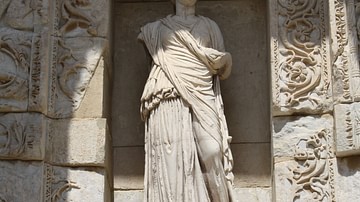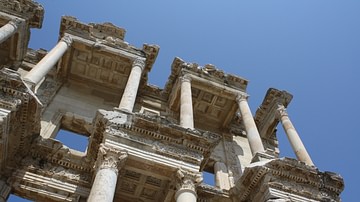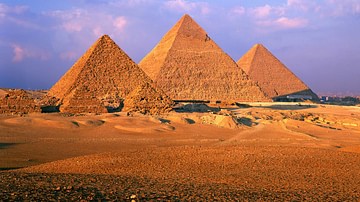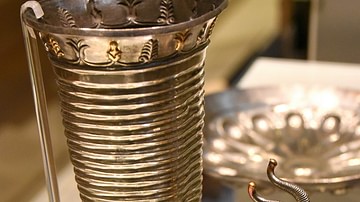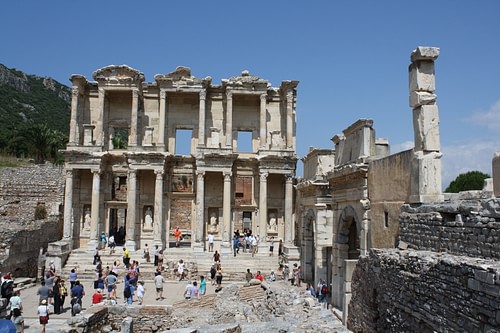
The Library of Celsus in ancient Ephesus, located in western Turkey, was a repository of over 12,000 scrolls and one of the most impressive buildings in the Roman Empire. Constructed in the 2nd century CE, it was named after the city's former Roman governor. Today, only the library's impressive facade remains of this once great building and is a silent witness to the city's stature as a great centre of learning and early Christian scholarship during the Roman period.
Ephesus
Ephesus (Ephesos), located on the west coast of Turkey, was once an important harbour city in the Greek world and then the Roman Empire. Settlement at the site dates back to the Bronze Age with the Mycenaeans, and it became renowned in the Classical period thanks to its cult of Artemis; the city being the most important site in the ancient Mediterranean honouring that deity. The city's great 6th-5th century BCE temple, now widely known as the Temple of Artemis at Ephesus, would become one of the Seven Wonders of the Ancient World and would pull in many ancient travellers and pilgrims. When Ephesus took over from Pergamon as the capital of Rome's Asian province (after 129 BCE) the city became even more cosmopolitan with immigrants coming from across Asia Minor and a large number of merchants from Italy settling there. As a great Roman city and administrative centre, it is no surprise, then, that it should boast an impressive public library, one of the amenities many Roman cities enjoyed.
Tiberius Julius Celsus Polemaeanus
Commissioned in 114 CE by Tiberius Julius Acquila and finished by his heirs, the library was built to commemorate his father Tiberius Julius Celsus Polemaeanus who had died the same year, aged 70. Celsus had been a member of the Roman Senate and he was, from 105 to 107 CE, the proconsul of Ephesus. Celsus had also been consul in Rome in 92 CE, where he was responsible for all public buildings, and he was one of the richest businessmen in the Asian city. The library was, then, a fitting memorial and burial place for one of Ephesus' grandees. Completed in 117 CE, Celsus was then entombed in a lead coffin encased in a marble sarcophagus decorated with high relief figures of Nike, Eros, rosettes and garlands. The sarcophagus was buried under the flooring near the apsidal wall. The library was, therefore, also a mausoleum or heroon.

The Library
The Celsus Library stands at the corner of Curetes street and the Marble road at the very heart of the city, just to the left of the agora, near its monumental arched entrance. The library is a typical example of the architectural style prevalent in the period under Emperor Hadrian (76-138 CE) when, especially in the East, highly decorative facades were in vogue which had multiple tiers and masses of projections, recessed false windows, columns, pediments, and statues.
Resting on a nine-stepped podium 21m (69 ft) in length, the impressive surviving facade of the library is richly decorated with relief carvings and has two stories - each with three pairs of columns capped with Corinthian capitals which support projecting architraves. The columns of the upper story are shorter and slimmer than those on the lower one but they do support a triangular pediment (central pair) and semicircular pediment (the two outer pairs). Between each pair of columns on the upper story is a large window. The facade, and indeed the whole building, was cleverly designed to make it look wider than it actually is. This trick was achieved by making the podium gently convex and having the side columns, capitals and rafters all slightly smaller than those in the centre of the building.
The library had three entrance doorways, each with elaborately decorated frames, with the central doorway being greater in height than the other two. The doorways each have a window above them, and they are flanked by four statues set back in niches. These figures with inscribed bases represented four qualities associated with the late governor:
- wisdom (sophia)
- intelligence (ennoia)
- knowledge (episteme)
- virtue (arete).
The interior of the library measured 16.72 m by 10.92 m (54.8 x 35.8 ft) giving some 180 square metres (2,000 square feet) of floor space, and it was paved with decorated marble. Part of the western wall is curved to form an apse. The walls were lined with niches for storage of the scrolls. There may have been around 12,000 scrolls which were intended to be consulted on the spot and not removed from the library, although some borrowing may have been permitted by a privileged few.
There was no second floor inside despite the appearance of the facade, but there was, running around the interior wall at the second-story level, a railed balcony giving access to higher-level niches. In order to reduce humidity and create a more stable interior temperature (which would have damaged the precious texts within the library), empty niches were constructed inside the walls. The interior also contained a large alcove which once contained a statue, probably of Celsus or his son who not only commissioned the building but who had left in his will a tidy sum of 23,000 dinars to buy scrolls for the library. The figure is now on permanent display at the Archaeological Museum of Istanbul.

Later History
In the 1st century CE, Ephesus had become the most important centre of early Christians in Asia with Paul the Apostle addressing an audience in the city's theatre and John the Evangelist likely spending his last years there. The city continued to thrive as a centre of learning, and the Celsus Library played its part in this achievement. The library and Christianity were closely connected since the new religion laid great emphasis on the written word in the form of sacred texts and commentaries, which was in marked contrast to the older pagan rites and rituals which were typically passed on orally by priests to initiates.
Unfortunately, in 262 CE the library was destroyed by fire during a Gothic invasion. However, the facade survived and repairs were made to the library in the late-4th century CE and a small fountain added next to the steps in front. Ephesus remained an important Christian city in Late Antiquity, hosting a great ecumenical council of bishops in 431 CE and receiving a huge new basilica in the mid-6th century CE. In the 10th century CE, an earthquake caused the facade to collapse. The library was excavated in 1904 CE and the sarcophagus of Celsus discovered. The facade was reassembled and then partially restored. The great statues of the building's facade were taken to Vienna after their discovery and so today they have been replaced by faithful copies.
